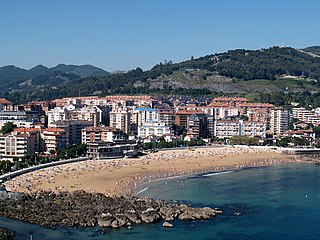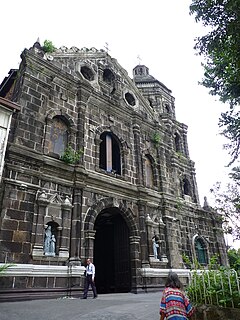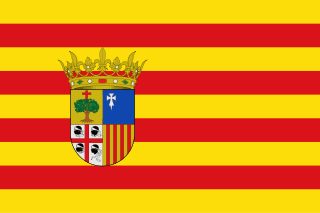
Mission La Purisima Concepción, or La Purisima Mission is a Spanish mission in Lompoc, California. It was established on December 8, 1787 by the Franciscan order. The original mission complex south of Lompoc was destroyed by an earthquake in 1812, and the mission was rebuilt at its present site several miles to the northwest.

The term Black Madonna or Black Virgin refers to statues or paintings of the Blessed Virgin Mary in which she, and often the infant Jesus, are depicted with black or dark skin. The Black Madonna can be generally found in Catholic and Orthodox countries.

Trujillo is a municipality located in Extremadura, an autonomous community of Spain in the Province of Cáceres. It had 9086 inhabitants. Originally settled on a granite knoll which was readily fortified, the town now extends to the South East of its original site. Trujillo is both a centre for tourism, with over 25 hotels, and a regional market town.

Tordesillas is a town and municipality in the province of Valladolid, Castile and León, central Spain. It is located 25 kilometres (16 mi) southwest of the provincial capital, Valladolid at an elevation of 704 metres (2,310 ft). The population was c. 9,000 as of 2009.

Mary of Jesus of Ágreda , OIC, also known as the Abbess of Ágreda, was a Franciscan abbess and spiritual writer, known especially for her extensive correspondence with King Philip IV of Spain and reports of her bilocation between Spain and its colonies in New Spain. She was a noted mystic of her era.

Tobarra is a municipality in the province of Albacete in Spain, with a population of c. 8,000 as of 2009.

Castro Urdiales is a seaport of northern Spain, in the autonomous community of Cantabria, situated on the Bay of Biscay. Castro Urdiales is a modern town, although its castle and the Gothic-style parish church of Santa María de la Asunción, date from the Middle Ages. Its chief industries are tourism, fishing, and the preservation of fish, especially sardines and anchovies, in oil. The "Lolin" and "La Castreña" anchovy canning factories serve as a reminder of the town's closeness to this industry and its proximity to the sea.

Alcalá del Valle is a city located in the province of Cádiz, Spain. According to the 2006 census, the city has a population of 5,355.

Brihuega is a municipality located in the province of Guadalajara, Spain. According to the 2007 census (INE), the municipality has a population of 2,835 inhabitants.

Segura de la Sierra is a small village in the province of Jaén, (Spain), that belongs to the region of Sierra de Segura in eastern Andalusia.

The Diocesan Shrine and Parish of Our Lady of the Abandoned is a Roman Catholic church in Marikina, the Philippines. The church enshrines one of several images of the Virgin Mary venerated as miraculous, which has received Papal recognition.
Our Lady of Bethlehem is a Flemish-style oil painting that arrived in Puerto Rico. Specialists in 15th-century art attribute the painting to the school of Brussels painter, Rogier van der Weyden, or to an anonymous disciple of his school.

La Alberca is a municipality in the province of Salamanca in the autonomous community of Castilla y León, Spain. It is the capital of Sierra de Francia Comarca.

The Cathedral of Cartagena in Spain, or the Cathedral of Santa María la Vieja, was a cathedral of the Diocese of Cartagena, located on the hill of La Concepción in the old town of Cartagena. It has been in ruins since 1939, when it was destroyed when Cartagena was shelled in the Spanish Civil War by Nationalist forces.

Aguilar del Río Alhama is a village in the province and autonomous community of La Rioja, Spain. The municipality covers an area of 54.11 square kilometres (20.89 sq mi) and as of 2011 had a population of 549 people. It is located in a low altitude mountainous area, in the foothills of the Iberian System. It belongs to the region of Rioja Baja and is washed by the waters of the Alhama river.

The Church of Our Lady of the Palm is a Roman Catholic church on the southwestern corner of the Plaza Alta in Algeciras, Spain. Listed as Bien de Interes Cultural by the Spanish Ministry of Culture in 1992, like the Spanish: Plaza Alta itself, it is an important city landmark.

The Holy Priory Church Cathedral Basilica of the Military Order of Our Lady Saint Mary of the Prado of Ciudad Real is located in Ciudad Real, Autonomous region of Castile-La Mancha, Spain. Construction began in the 15th century in Gothic style, although it has elements of late Romanesque, Renaissance and Baroque styles; it has undergone many restorations with the first remodelling credited to Alfonso X since the Romanesque period. It was completed in the mid 16th century after construction of the roof vaults. The tower was built in the early 19th century. The structure is a monument indexed in the Spanish heritage register of Bien de Interés Cultural under the reference RI-51-0000514.

The Santa Ana Church, also known as the Parish of Our Lady of the Abandoned, is a Spanish colonial period church located in the district of Santa Ana in Manila, Philippines. The parish was established by the Franciscan missionaries in 1578 under the patronage of Saint Anne. The present stone church was constructed by Father Vicente Inglés, OFM from 1720 to 1725 and was dedicated to its present patron, the Our Lady of the Abandoned. The revered image of its patron was made in Valencia,Spain in 1713 and arrived in the Philippines in 1717.

La Ermita de la Virgen de la Peña de Mijas is a monastery and Catholic holy site in Mijas, Malaga province, Spain. It was excavated in the rock around 1548 by Mercedarian friars. According to tradition, Marian apparitions began in 1586, when two children, Juan and Asuncion Bernal Linaire, are credited with having a vision of Mary above the church. According to the tradition, they saw a white dove on the tower of the Castillo which transfigured into the virgin and notified their father, who reported the hiding place to the local church authorities of Mijas.





















